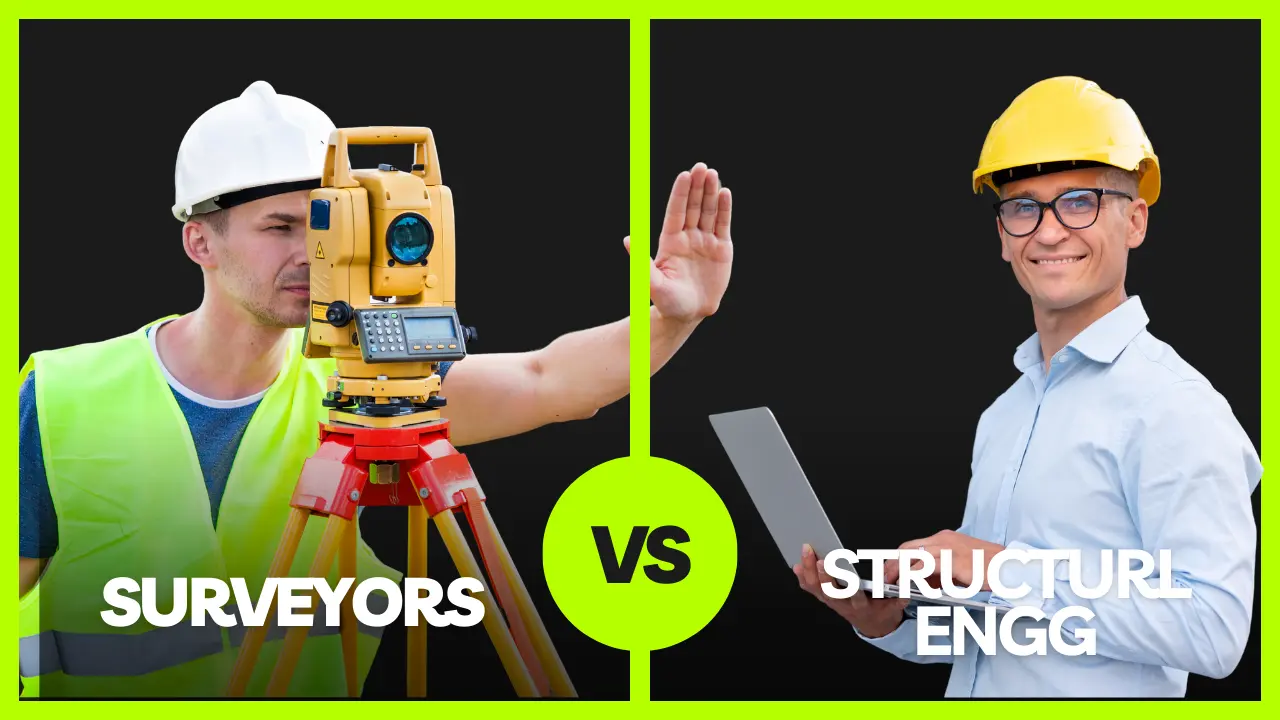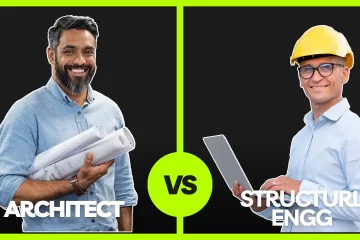In the expansive world of construction and infrastructure development, two essential professions, structural engineers and surveyors, play critical roles in shaping the physical landscape.
While both contribute significantly to the built environment, their responsibilities, expertise, and the stages of a construction project where they come into play are distinct.
In this comprehensive exploration, we will delve into the intricacies of structural engineering and surveying, unravelling the differences, examining their respective contributions, and highlighting the collaborative dynamics that drive successful construction projects.
Structural Engineers vs Surveyors – Major Differences between In Simple Way:
| Aspect | Structural Engineers | Surveyors |
|---|---|---|
| Primary Focus | Design and analyze structural components of buildings and infrastructure. | Measure and map land, including boundaries, elevations, and contours. |
| Scope of Work | Ensure structural integrity, stability, and safety of construction projects. | Provide precise measurements and data for land development, mapping, and construction. |
| Key Responsibilities | Develop blueprints, analyze materials, and oversee construction to meet safety standards. | Conduct land surveys, create maps, and provide data crucial for planning and development. |
| Materials Involved | Work with materials like steel, concrete, and wood for structural components. | Utilize surveying instruments and tools, such as total stations and GPS devices. |
| Common Analysis Tools | Utilize structural analysis software, finite element analysis, and engineering principles. | Use surveying equipment and software for accurate measurements and data collection. |
Check out the video as well if you want to know the difference
What is the role of a Structural Engineer?

Structural engineers are the architects of safety, ensuring that buildings, bridges, and various structures stand tall with stability and resilience. Their role revolves around the design, analysis, and implementation of structures, employing principles of physics, mathematics, and material science to guarantee structural integrity.
1. Technical Expertise and Structural Design:
At the core of a structural engineer’s responsibility lies a profound understanding of materials, structural behaviour, and the application of engineering principles. They translate architectural visions into detailed designs, focusing on the safe and efficient utilization of materials.
You May Also Like: Best Structural Engineering Software
2. Collaboration with Architects:
Structural engineers collaborate closely with architects, providing the technical expertise necessary to bring creative visions to fruition. This partnership ensures that the aesthetics of a structure align seamlessly with its structural feasibility, combining form and function for a harmonious result.
You May Also Like: Best Laptops For Structural Engineers
What is the Role of a Surveyor?

Surveyors are the ground-level pioneers, laying the foundation for accurate spatial data that serves as the blueprint for construction projects. Their role revolves around measurement, mapping, and land assessment to ensure precision and compliance with legal and design parameters.
1. Precision Mapping and Land Assessment:
Surveyors employ advanced instruments to measure and map the Earth’s surface, providing accurate data on the topography, boundaries, and existing structures. This information is critical for effective project planning and design.
2. Legal and Regulatory Compliance:
Surveyors play a vital role in ensuring that construction projects adhere to legal and regulatory requirements. They establish property boundaries, assess land suitability, and provide essential data for compliance with zoning laws and building codes.
Collaborative Dynamics in Construction Projects Of Structural Engineers & Surveyors
While structural engineers and surveyors have distinct roles, their collaboration is instrumental in the success of construction projects. The synergy between detailed structural design and accurate spatial data ensures a comprehensive and precise approach to construction.
1. Early Collaboration for Project Precision:
Effective collaboration begins at the project’s inception, where surveyors provide accurate land data that influences the structural engineer’s design. Early cooperation ensures that designs align with the landscape’s realities.
2. Precision Mapping for Structural Accuracy:
Surveyors contribute to structural accuracy by providing precise mapping data. This information assists structural engineers in understanding ground conditions, making informed decisions about foundation design, and ensuring the stability of the structure.
Educational Paths and Skill Sets Of Structural Engineers vs Surveyors
Understanding the educational paths and skill sets required for each profession sheds light on the depth of knowledge and expertise that structural engineers and surveyors bring to construction projects.
1. Structural Engineering Education:
Structural engineers typically hold a bachelor’s degree in civil engineering or a related field. Specialized coursework in structural engineering equips them with the skills needed for detailed structural analysis and design.
2. Surveying Education and Professional Credentials:
Surveyors often pursue degrees in surveying, geomatics, or a related field. Professional credentials, such as licensure, are common in the surveying profession, signifying a surveyor’s competence and adherence to ethical standards.
Technical Precision vs. Spatial Accuracy for Structural Engineers & Surveyors
The comparison between structural engineers and surveyors often centers around technical precision in design and spatial accuracy in mapping. Both aspects are crucial for the successful implementation of construction projects.
1. Importance of Technical Precision:
Structural engineers prioritize technical precision, ensuring that every component of a structure is designed to withstand various loads and environmental factors. Their calculations and analyses are crucial for safety and stability.
2. Significance of Spatial Accuracy:
Surveyors focus on spatial accuracy, providing precise measurements and mapping data that influence the design and implementation of construction projects. Accurate spatial data is essential for effective project planning and compliance with regulations.
Decision-Making Processes For Structural Engineers vs Surveyors
The decision-making processes of structural engineers and surveyors reflect their distinct roles within construction projects, emphasizing either technical design or spatial accuracy.
1. Structural Engineering DecisionMaking:
Structural engineers make decisions based on technical considerations, relying on their expertise in materials, physics, and structural analysis. Their decisions ensure that the construction meets safety and stability standards while adhering to architectural and design goals.
2. Surveying DecisionMaking:
Surveyors make decisions based on spatial data, employing precision instruments and techniques to measure and map the landscape. Their decisions influence project planning, design, and compliance with legal and regulatory requirements.
Technological Advancements in Structural Engineering and Surveying:
Advancements in technology have significantly influenced the way both structural engineers and surveyors approach their work, enhancing precision, efficiency, and collaboration.
1. Building Information Modeling (BIM) in Structural Engineering:
BIM is a collaborative approach that allows structural engineers to create digital representations of a project, facilitating better coordination and communication among various stakeholders. BIM enhances the accuracy of design and analysis processes.
2. Advanced Surveying Technologies:
Surveyors leverage cutting-edge technologies such as Global Navigation Satellite Systems (GNSS), LiDAR (Light Detection and Ranging), and unmanned aerial vehicles (UAVs) for accurate mapping and measurements. These technologies enhance efficiency and precision in surveying.
Career Trajectory and Advancement For Structural Engineers & Surveyors
Both structural engineers and surveyors have avenues for career growth and advancement within the construction and geospatial industries.
1. Structural Engineering Career Trajectory:
Structural engineers may advance by specializing in areas such as seismic design, forensic engineering, or project management. Leadership roles, such as becoming a chief engineer or principal, offer avenues for career growth.
2. Surveying Career Trajectory:
Surveyors can progress in their careers by gaining experience in diverse projects, obtaining professional licensure, and staying updated on technological advancements. Senior roles in surveying firms or managerial positions are common career advancements.
Salary Comparison Of Structural Engineers & Surveyors
The salaries of structural engineers and surveyors vary based on factors such as experience, location, industry, and project scale.
1. Structural Engineer Salaries:
Salaries for structural engineers are competitive, with variations based on factors like experience and specialization. Senior roles or those with advanced expertise may command higher salaries.
2. Surveyor Salaries:
Surveyors typically earn competitive salaries, reflecting the importance of their role in providing accurate spatial data for construction projects. Senior surveyors or those with specialized skills may earn higher salaries.
FAQ’s
Do I Need a Structural Engineer or Surveyor?
If you’re planning construction, you need both but at different stages. A structural engineer ensures your building is safe and sound, while a surveyor helps with accurate land measurements and legal compliance.
What Is the Difference Between an Engineer and a Surveyor?
An engineer designs structures, ensuring they’re stable and safe. A surveyor measures land, providing precise data for construction planning and legal compliance. Both are crucial in different ways.
Who Comes First in Construction?
Typically, a surveyor comes first. They measure and map the land accurately, providing data for design. Structural engineers follow, using this data to create safe and sound building designs.
What Is the Difference Between Structural Survey and Structural Inspection?
A structural survey is a comprehensive examination of a property’s condition. A structural inspection, done by a structural engineer, focuses on the safety and stability of a building’s components. The survey is broader, while the inspection is specific to structural aspects.
Final Thoughts:
In the intricate dance of construction and infrastructure development, structural engineers and surveyors are indispensable partners, each contributing unique skills and expertise.
While the structural engineer focuses on technical precision in design and analysis, the surveyor ensures spatial accuracy, laying the groundwork for successful project implementation.
Their collaboration, grounded in mutual respect for their distinct roles, results in the creation of structures that are not only safe and resilient but also seamlessly integrated into the landscape.
The synergy between precision in structural engineering and accuracy in surveying sets the stage for construction projects that stand as testaments to human ingenuity and thoughtful planning.
You May Also Like:
Civil Engineers vs Structural Engineers: Who Is Better?
10+ Best Tablets For Civil Engineers Top Picks Only
10+ Best Laptops For Civil Engineers & Students
15+ Best Gifts For Civil Engineers – Unique Ideas




